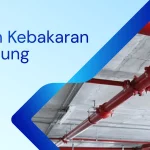Fire is one of the most destructive disasters, not only threatening lives but also capable of crippling a business in an instant. Amidst the rapid development of skyscrapers and industrial zones in Indonesia, a reliable fire protection system is no longer an option—it is an absolute necessity. This article will provide an in-depth look at the importance of fire protection, current standards, types of systems, and the industry's prospects in Indonesia.
The Reality of Fire Risk in Major Cities
The high rate of urbanization, especially in a metropolis like Jakarta, is directly proportional to the increasing risk of fire. Recent data reveals an alarming fact: out of thousands of high-rise buildings inspected in Jakarta, a staggering 694 were declared non-compliant with adequate fire protection standards.
This figure serves as a stark reminder that negligence towards safety standards can have fatal consequences. Therefore, understanding and implementing a comprehensive fire protection system is the frontline defense for protecting investments, property, and most importantly, human lives.
Understanding Fire Protection Systems: Active vs. Passive
Broadly, fire protection systems are divided into two main categories that work synergistically to provide maximum protection.
Active Fire Protection Systems
These systems are designed to respond directly when a fire occurs by detecting and extinguishing it. Some of their main components include:
- Portable Fire Extinguishers: This is the first line of defense for small-scale fires and must be available at strategic points throughout a building.
- Sprinkler Systems: A network of pipes installed in the ceiling that automatically sprays water upon detecting excessive heat from a fire.
- Hydrant Systems: Provides a high-pressure water supply for firefighters to combat large-scale fires. It consists of pillar hydrants outside the building and hydrant boxes inside.
- Detection and Alarm Systems: (Fire Alarm Serves as an early warning through smoke or heat detectors, which will sound an alarm to initiate evacuation.
- Special Suppression Systems: Uses agents other than water, such as gas or foam, designed for high-risk and sensitive areas like server rooms, data centers, or chemical storage areas.
Passive Fire Protection Systems
Passive systems function to contain a fire and slow its spread, providing more time for evacuation. This is achieved by using fire-resistant building elements, such as
- Fire-rated doors and walls.
- Construction materials with a specific fire-resistance rating.
- Fire-retardant coatings.
Fire Protection Standards and Regulations in Indonesia
The Indonesian government has regulations that mandate every building, especially high-rises (over 4 floors or 15 meters in height) and public facilities, to have a fire protection system. However, the challenge lies in the comprehensiveness of these standards and the enforcement of their implementation.
Compared to neighboring countries, Indonesia's technical standards are considered to have room for improvement to become more detailed and aligned with international benchmarks. The hope is that stricter regulations and higher standards can be realized soon to improve safety levels nationwide.
Opportunities and Challenges in the National Fire Protection Industry
In line with national strategic programs such as industrial downstreaming, infrastructure development, and the boom in data center and manufacturing plant construction, the prospects for the fire protection industry in Indonesia are incredibly bright.
Promising Market Growth Prospects
Indonesia currently ranks 9th in the world for the number of skyscrapers, and this trend is predicted to continue. This growth directly creates a massive demand for reliable and innovative fire protection solutions and products, from basic systems to advanced AI-based technology.
Key Industry Challenges
Behind the great opportunities, the industry also faces challenges, particularly price competition and the need for continuous innovation. Furthermore, raising awareness among building owners and industry players about the importance of investing in quality systems—not just meeting minimum requirements—is a key factor that needs continuous improvement.
In conclusion, fire protection is a vital element in the modern development ecosystem. Ignoring it is equivalent to leaving assets and lives at risk. For building owners, industry players, and the government, ensuring every structure is protected by a reliable system is a shared responsibility towards creating a safer and more resilient Indonesia.







